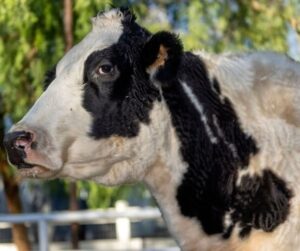Is there no hack climate change enthusiasts won’t try? From frankenfoods to toilets that turn waste into ash, the eco-warriors are bent on finding solutions to stop the world from heading into another ice age or becoming a desert. Billionaire Bill Gates is leading the charge against bovine offenders, recently donating $4.7 million to a company that wants to put masks on cows.
Climate Change Hack: Mask that Cow!
Remember when Representative Alexandria Ocasio-Cortez (D-NY) claimed cow gas was one of the biggest contributors to climate change? Well, she had the right animal but was ass-backward: it’s the cow’s burp, not wind breaking, that emits so much methane into the atmosphere. Zero Emissions Livestock Project (ZELP) says it has the answer to the problem of the belching beasts, and Gates’ donation will help the company usher in that reality.
The plan is to use artificial intelligence masks that go around the cow’s head. When the creature burps, exhaling methane, the mask will oxidize the gas and then release it as carbon dioxide and water vapor, according to ZELP. And, as The Defender explained, “It also has sensors that continuously collect millions of data points on the animals that are processed by machine learning algorithms.” The UK-based company said, “Our AI is trained to detect heat, flag welfare conditions, and identify the most efficient animals with a high-level of accuracy.”
The Bill & Melinda Gates Foundation just announced a $4.7 million grant for a company that sells face masks for cows.
You couldn’t make this stuff up. pic.twitter.com/U8vkorBKwr
— Critical Sway (@CriticalSway) March 11, 2023
Flashback to the mask-wearing days of the pandemic. Remember how uncomfortable that was? Now imagine being a cow and having a contraption strapped to your head 24-7 that not only measures your burps, but every other bodily function as well. What happens if ZELP’s AI determines a cow isn’t efficient enough? Does it get “put out to pasture”?
Not surprisingly, there is a lot of criticism about this newest invention, despite the fact that it was one of four winners of the inaugural Terra Cart Design Lab competition launched by then-Prince Charles, who said it was “fascinating.” Howard Vlieger, a third-generation farmer, said the invention is powered by greed. “This is what you get when you combine greed and stupidity.”
ZELP collaborates with Cargill, a giant in the agriculture industry, and leases out the smart masks to farmers and sells carbon offset credits, according to researcher and investigator Critical Sway. But Vlieger said cows are not the problem. “When the settlers worked their way across the plains, there were millions of buffalo. If ruminant animals were the problem, why didn’t we have climate change problems then?”
Besides cattle, other ruminant animals include antelopes, deer, giraffes, goats, and sheep. They are mostly characterized as having a four-chambered stomach and two-toed feet. Imagine trying to put these masks on giraffes!
The Science Behind It All
Do we really need to put AI masks on our cows for climate control?
First, the facts.
Last year, a study involving satellites examined methane emissions from the Bear 5 cow feedlot near Bakersfield, CA, and found “the lot was emitting a range of 977 pounds (443 kilograms) to 1,472.69 pounds (668 kg) of methane per hour,” reported Space. “If these emissions were sustained for a year, it would add up to over 5,000 tons of methane to Earth’s atmosphere.” Yes, someone really went to space to study cow burps.

(Hans Gutknecht/MediaNews/Los Angeles Daily via Getty Images)
According to Insider: “A single dairy cow can produce up to 130 gallons of methane per day. And their burps account for 95% of a cow’s methane emissions. There are approximately one billion cattle worldwide.” The outlet added, “Cows and other farm animals produce about 14% of human-induced climate emissions.”
Now the rebuttal.
Some experts argue that letting cows be cows is actually better for the environment. The problem is not that they belch methane; it’s how and where they graze. For example, conventional livestock production, also known as factory farming, confines large numbers of animals in a concentrated feeding area. The Savory Institute, a regenerative agriculture organization that advocates for a more natural approach to livestock, said these farm practices manipulate “pieces of the ecosystem in an effort to maximize production and profits, thereby leading to the complication and expense with unintended consequences.” The authors of the study said an intact ecosystem effectively balances ruminant methane production and breakdown, according to The Defender.
Richard Teague, Ph.D., a professor emeritus and grazing ecologist at Texas A&M AgriLife Research & Extension Center, found that ruminant animals reduce greenhouse gas emissions and provide services that increase carbon sequestration and reduce environmental damage with regenerative crop and grazing management. When cows are allowed to open graze “under appropriate management results in more carbon sequestration than emissions,” he said.
“The potential for tumors and other ill health effects are significant,” Vlieger said of the smart masks. “History will show that the vast majority of so-called environmentally beneficial projects like this are going to make Bernie Madoff look like an altar boy.”
Do you have an opinion about this article? We’d love to hear it! If you send your comments to [email protected], we might even publish your edited remarks in our new feature, LN Readers Speak Out. Remember to include the title of the article along with your name, city, and state.
Please respect our republishing guidelines. Republication permission does not equal site endorsement. Click here.

